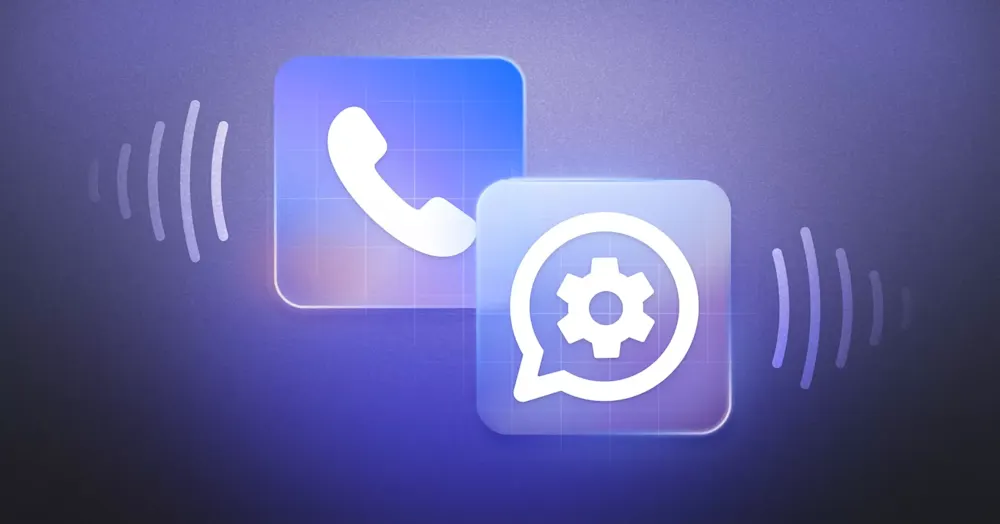
Upgrade auf WhatsApp API ohne Sprachanruf
Erfahren Sie, wie Sie auf WhatsApp API upgraden, ohne Sprachanrufe zu verlieren. Verbinden Sie Nachrichten und Stimme, um Vertrauen zu schaffen, komplexe Probleme zu lösen und sich abzuheben.

Planen Sie, WhatsApp-Marketing zur Umsatzsteigerung einzusetzen? Wenn Ihr E-Mail-Marketing nicht mehr funktioniert, kann WhatsApp Marketing genau das sein, was Sie brauchen. Tatsache ist, dass die Menschen E-Mails weniger für die Kommunikation im Allgemeinen verwenden; Instant Messaging ist der Weg in die Zukunft.
Und wo senden die meisten Leute Nachrichten? WhatsApp! Mitüber 2 Milliarden Nutzern auf der ganzen Weltist WhatsApp die beliebteste Messaging-App. Wir teilen alles, was du wissen musst, um mit WhatsApp Marketing loszulegen, zusammen mit ein paar Beispielen dafür, wie Unternehmen WhatsApp erfolgreich für Marketing nutzen.
WhatsApp Marketing ist eine Art Instant Messenger Marketing , das Unternehmen hilft, ein breiteres Publikum zu erreichen, persönliche Kontakte mit Kunden knüpfen und letztlich den Umsatz steigern.
Eine typische Marketing-Strategie beinhaltet mehrere Berührungspunkte, um Perspektiven einzubinden und sie letztlich in Kunden zu verwandeln. Traditionell beginnt dies mit Werbung. Unternehmen streben dann an, Kontaktinformationen zu erhalten, um das Marketing per E-Mail fortzusetzen.
WhatsApp-Marketing funktioniert ähnlich, aber anstatt eine E-Mail-Adresse einzugeben, müssen alle Interessenten dem Unternehmen nur eine Nachricht auf WhatsApp senden. Das Unternehmen kann sich dann weiter mit der Aussicht in Verbindung setzen, um ihr Interesse zu schüren und es zu einem Kauf zu bewegen.
Marketing über WhatsApp hat viele Vorteile für Unternehmen jeder Größe. Wenn Ihre Kunden WhatsApp verwenden, müssen Sie sie dort ansprechen. Hier nur einige der Gründe:
WhatsApp Marketing erreicht proaktiv Perspektiven, wo sie die meiste Zeit verbringen. Im Gegensatz zu den meisten Messaging-Apps ermöglicht WhatsApp das Starten von Unterhaltungen mitKontakten, die sich für das Hören von entscheiden.
Es ist auch kosteneffektiv. WhatsApp Business Appist kostenlos, daher ist es großartig für kleine Unternehmen mit einem begrenzten Budget. Größere Unternehmen werdenWhatsApp Business APIverwenden müssen, was mehr kostet, aber hohe Erträge hat. Diese Optionen werden wir später noch diskutieren.
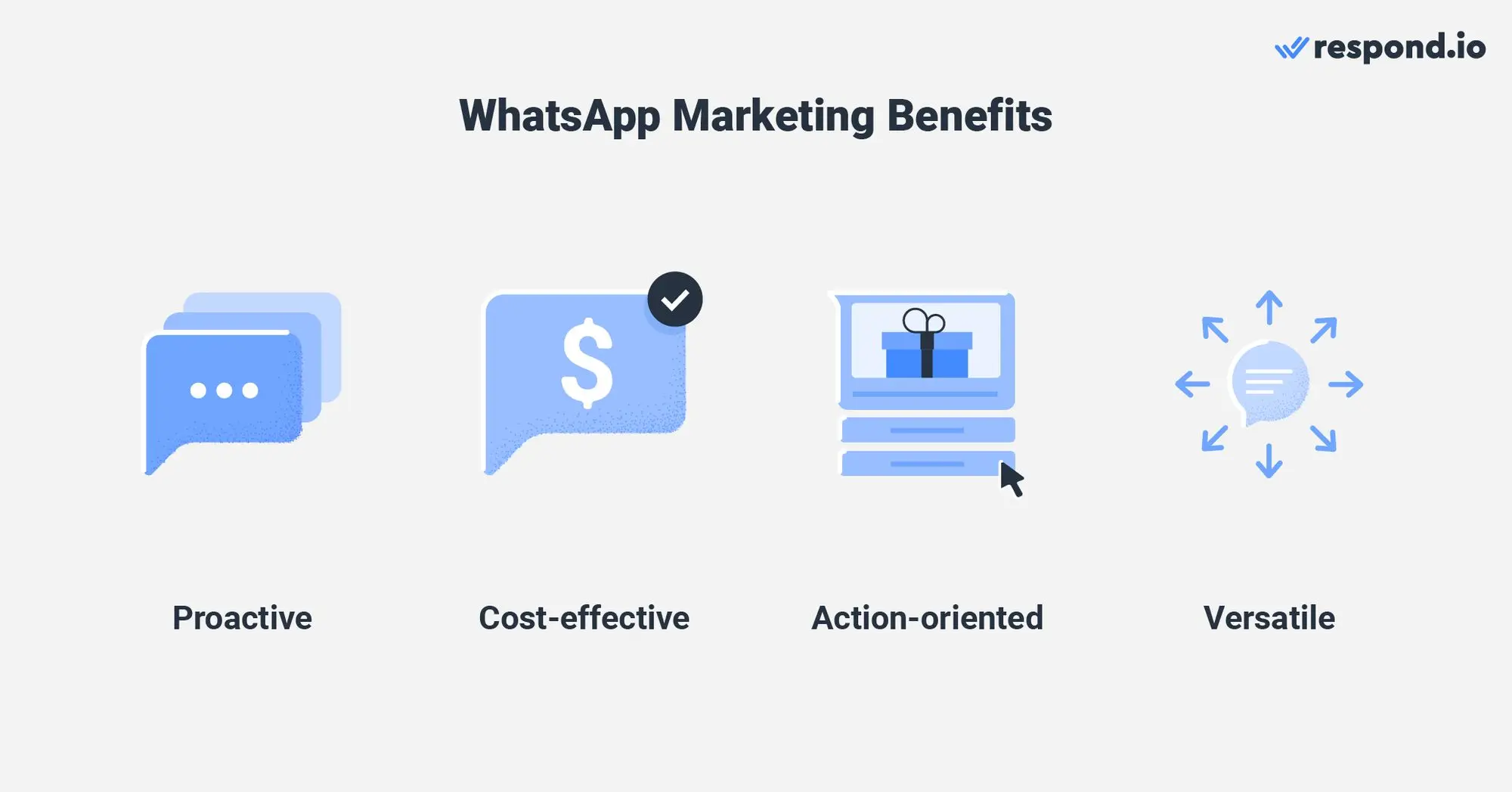
WhatsApp Marketing treibt die Aussichten zum Handeln mit interaktivenAntwortschaltflächen oder Listennachrichten an. Automatisierung kann auch genutzt werden, um Gespräche mit einer realistischen Person zu erleichtern, wie im-Beispiel von Maggis Chef KimKampagne, auf den wir später eingehen werden.
Schließlich verfügt WhatsApp über vielseitige Anwendungen im gesamten Marketing-Trichter. Verwenden Sie einen WhatsApp Link inKlick-to-Chat Anzeigenund Lead Generation-Kampagnen, um Kontakte zu erhalten; dann verwenden Sie es als Remarketing-Werkzeug, um die Perspektiven über Promotionen zu informieren und wiederholte Einkäufe zu fördern.
Verwandeln Sie Gespräche in Kunden mit der offiziellen WhatsApp-API von respond.io. ✨
Verwalten Sie WhatsApp-Anrufe und -Chats an einem Ort!
Bevor Sie WhatsApp für das Marketing verwenden, müssen Sie über die verschiedenen Kontotypen und deren Funktionen informiert sein.
Es gibt zwei Arten von Konten, die Sie für WhatsApp Marketing verwenden können: WhatsApp Business App und WhatsApp API. Jeder hat seine eigenen Merkmale und Einschränkungen. Für kleine Unternehmen kann WhatsApp Business App für Ihre Anwendungsfälle ausreichen.
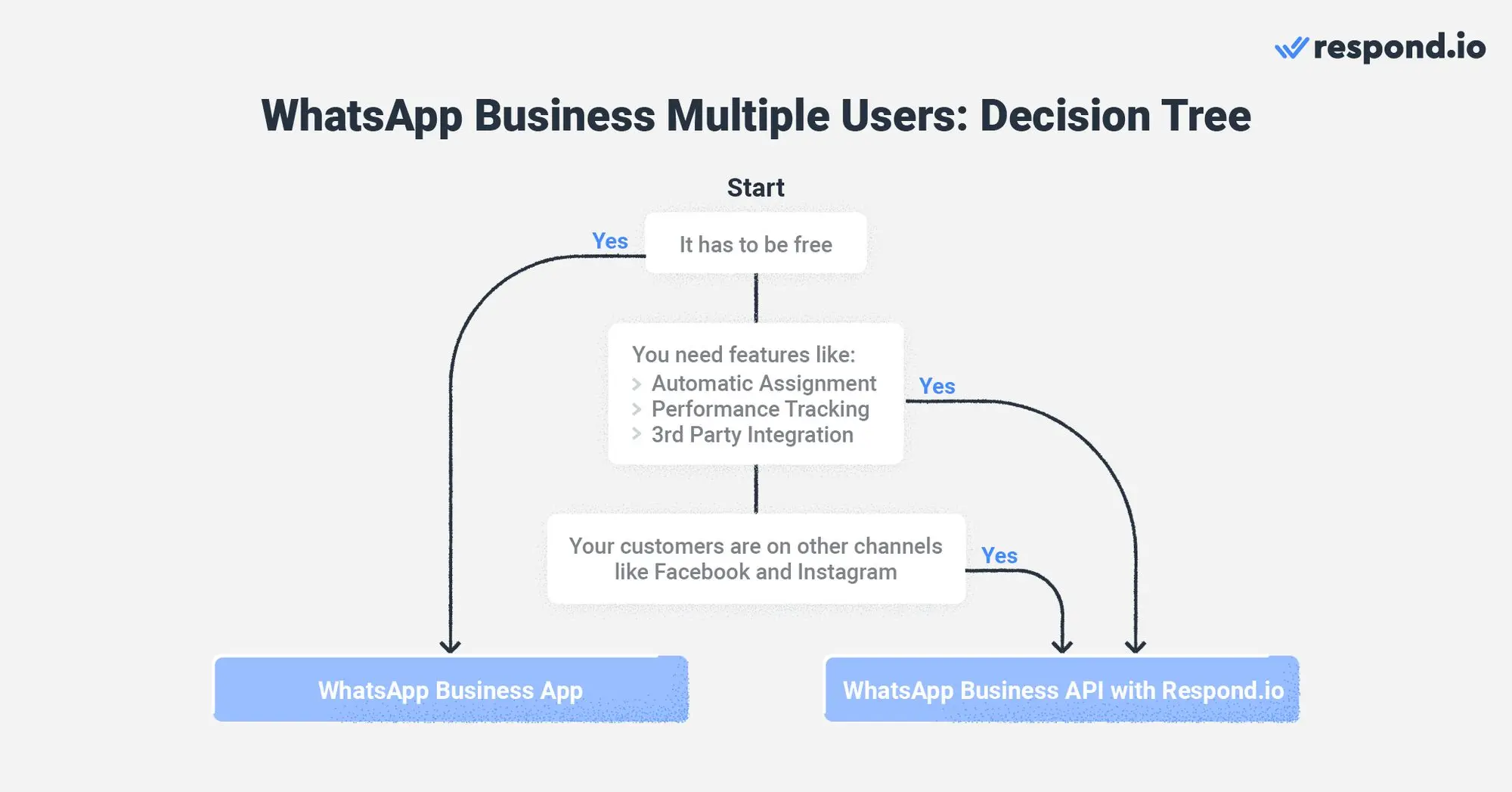
Für mittelständische bis große Unternehmen, die WhatsApp Business mit mehreren Benutzernverwenden möchten, empfehlen wir WhatsApp API. WhatsApp API ermöglicht Ihnen eine Verbindung zu einer Business-Messaging-Plattform wie antworten. o zum Einrichten von angepassten Workflows, um den AgentenKontakte zuzuweisen und mehr.
Die WhatsApp Business App verfügt über keine erweiterten Funktionen für das Marketing, wie zum Beispiel die Möglichkeit, Drip-Kampagnen einzurichten, und Werbe-Push-Mitteilungen. Diese Aktionen können nur mit WhatsApp API durchgeführt werden, die mit respond.io verbunden ist.
Ein weiterer Nachteil der WhatsApp Business App ist, dass Sie für WhatsApp Massenmitteilungen Broadcast-Listen erstellen müssen. mit einem Maximum von 256 Kontakten pro Liste. Auf der anderen Seite mit WhatsApp API, du kannst Massen-Nachrichten an eine unbegrenzte Anzahl von Kontakten senden abhängig von deiner Stufe.
WhatsApp Business App ist völlig kostenlos. WhatsApp API verursacht Kosten, einschließlich der Respond.io Account-Gebühr,Business Solutions Providers (BSPs) Gebühren undWhatsApp conversation fees. Nichtsdestotrotz überwiegen die potenziellen Vorteile von WhatsApp Werbemitteilungen bei weitem die Kosten.
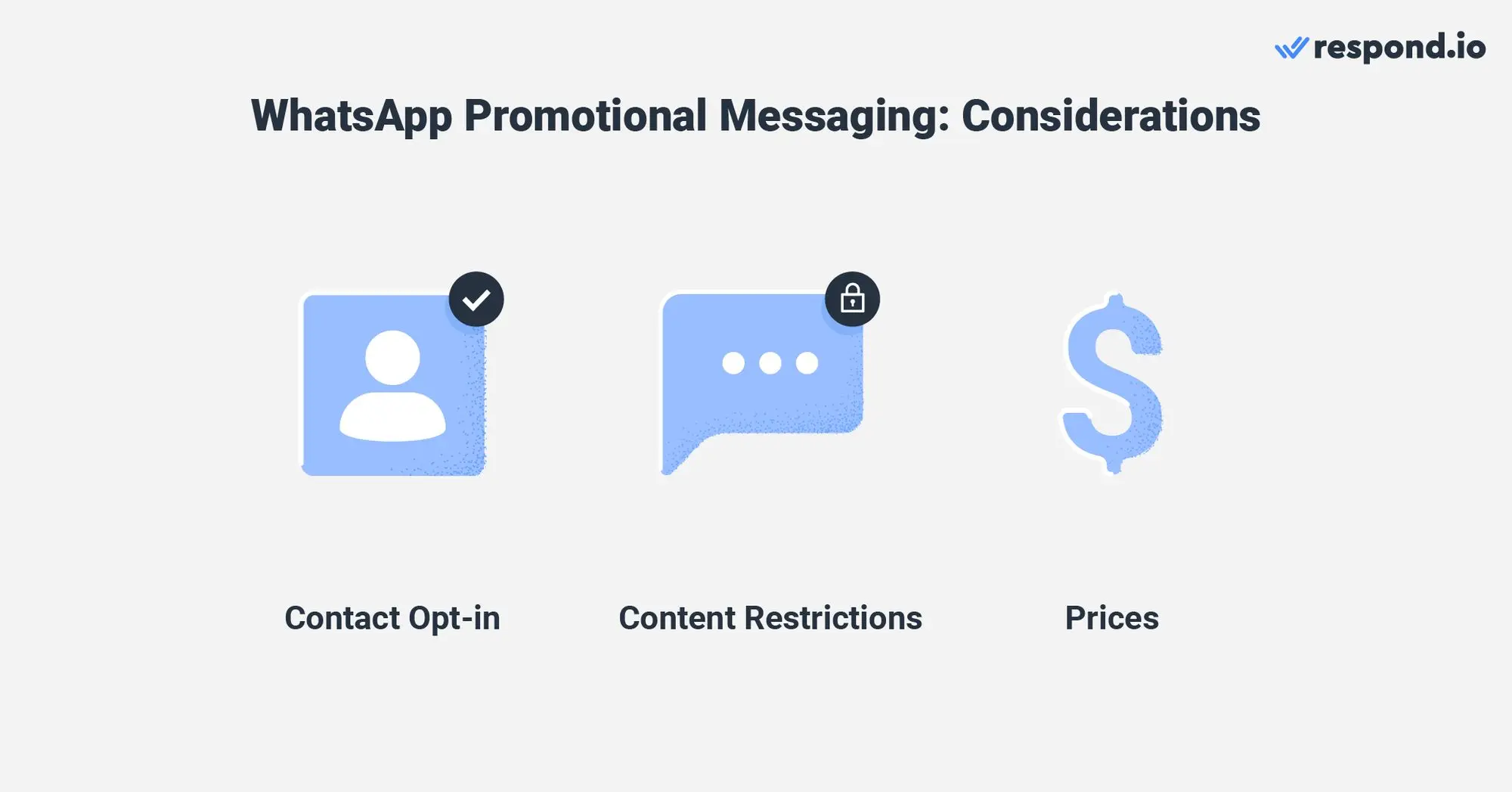
Mit WhatsApp Business App und WhatsApp API gibt es einige Bestimmungen, denen Sie folgen müssen. Niemand mag Spam, und wenn Sie verdächtigt werden, Spam zu senden, kann Ihr Konto gesperrt werden.
Erstens müssen Kontakte zustimmen, um Werbebotschaften zu erhalten. Kontakte können sich entscheiden, indem Sie eine Nachricht senden, ein Formular ausfüllen, Ihren WhatsApp QR-Code scannen oder über eine Klick-zu-Chat-Anzeige.
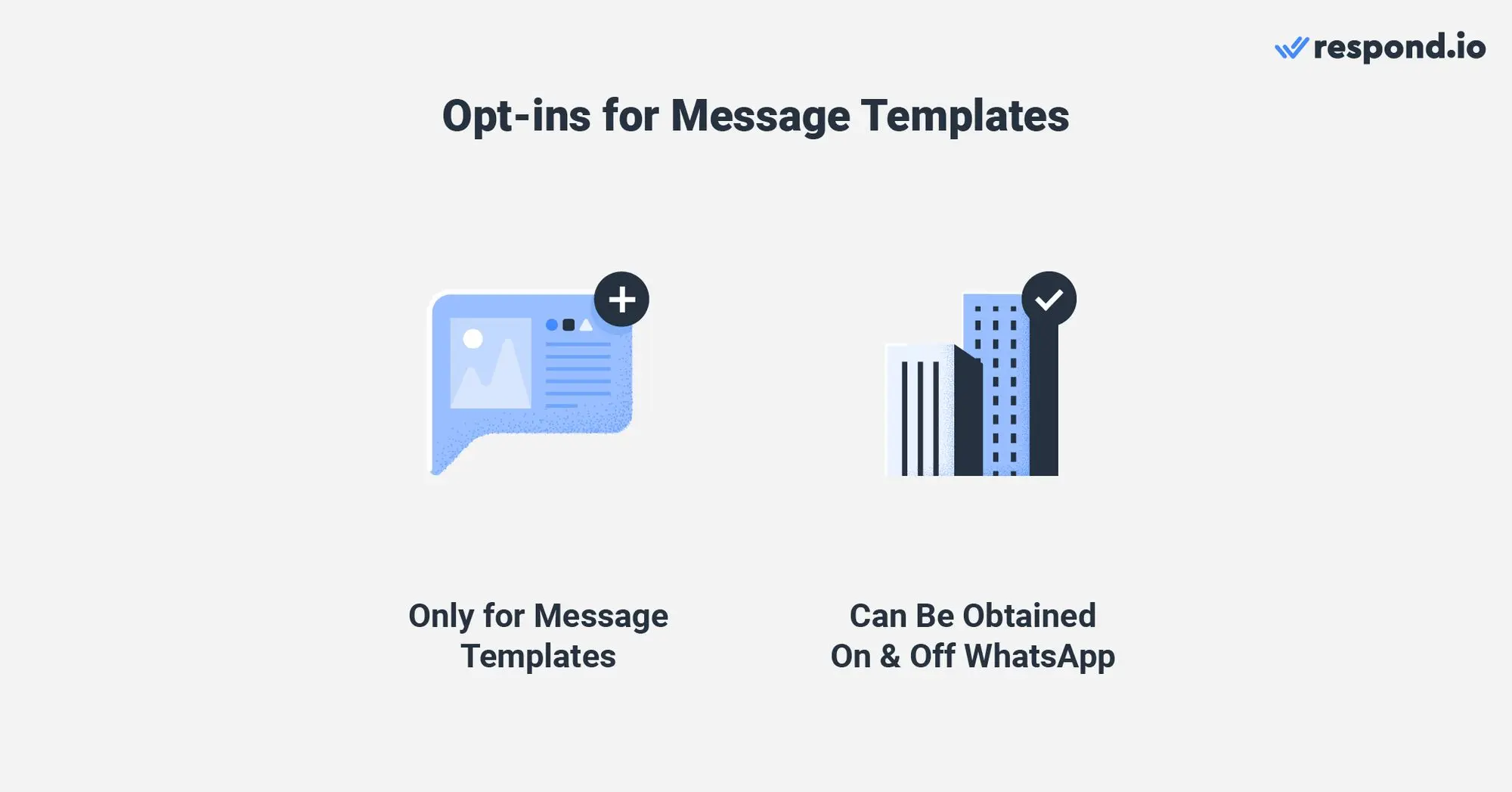
Sie müssen sich auch an die Bedingungen in WhatsAppBusiness undCommerce Richtlinien halten. Dies beinhaltet nur die Verwendung vorab genehmigterNachrichtenvorlagen für Werbeinhalte.
Ab dem 1. Juli 2025 wird WhatsApp pro Nachricht für Marketing- und Gebrauchsvorlagen berechnen und nicht pro Unterhaltung.
Sobald Sie Ihr WhatsApp Business App oder WhatsApp API-Konto bereit haben, ist es einfach, WhatsApp in Ihre Marketingstrategie zu integrieren. Werde kreativ und verwende respond.io um den Prozess zu rationalisieren.
Der Marketingprozess wird am besten durch einen Trichter illustriert. Ihre WhatsApp Marketing-Strategie kann auf die gleiche Weise gesehen werden. Wir zeigen Ihnen Schritt für Schritt, wie Sie WhatsApp verwenden, um die Aussichten auf den Trichter zu lenken.
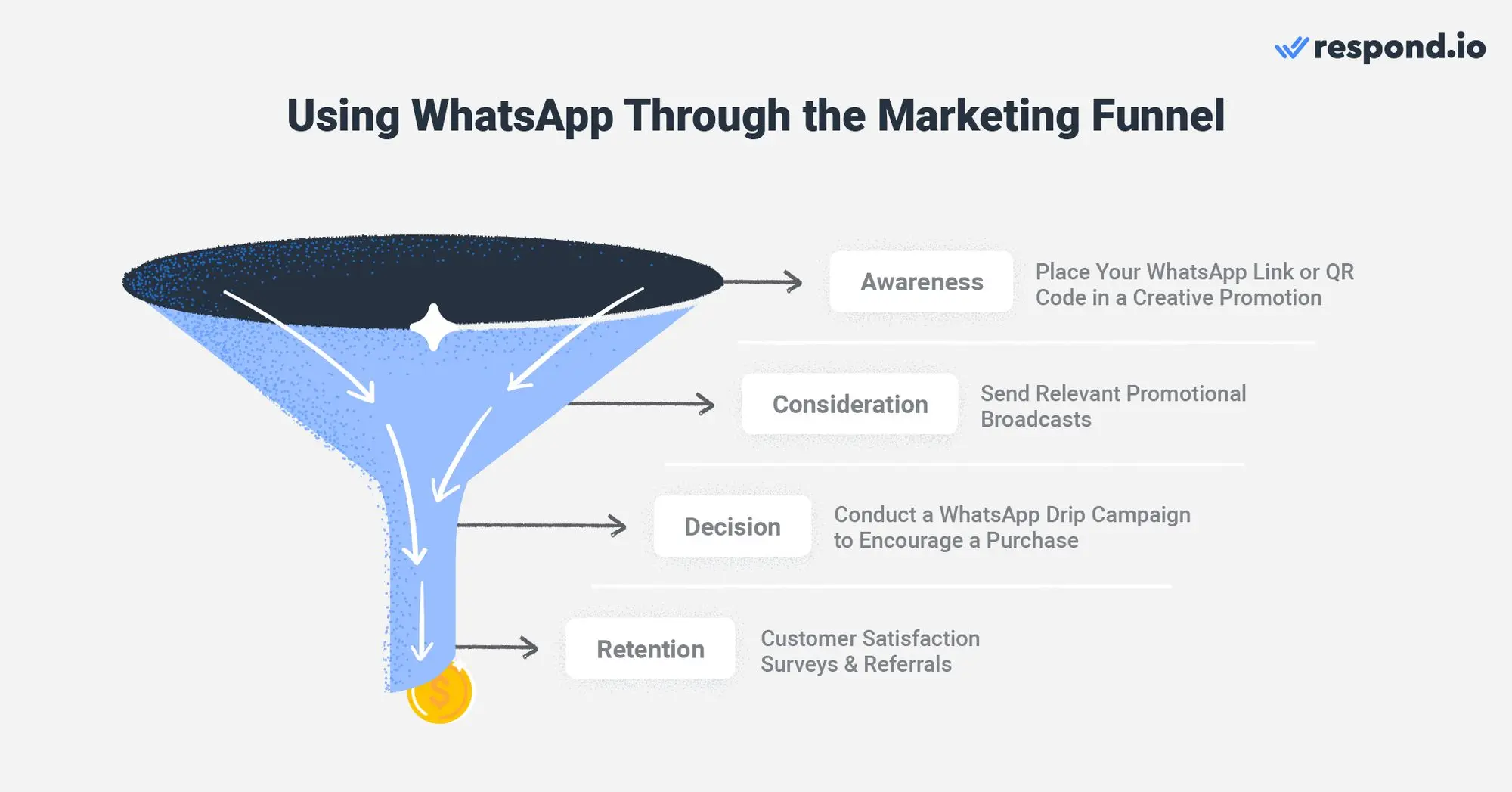
Da Sie Interessenten dazu bringen müssen, Ihnen eine Nachricht zu senden, bevor Sie Werbeaktionen versenden, finden Sie kreative Wege, dies zu tun. Wir sprechen später über ein paar Beispiele. Denken Sie darüber nach, was für Ihr Publikum attraktiv ist.
Erstellen Sie einen WhatsApp Link oder QR Code mit respond.io um Werbung oder Social Media Werbeaktionen zu erstellen. Klicke auf Anzeigen und mache es den Interessenten leicht zu antworten. Alles, was sie tun müssen, ist auf den WhatsApp Link zu klicken, und Sie erhalten ihre Telefonnummer; es ist nicht notwendig, ein Formular auszufüllen. Sie können eine WhatsApp-Autoreply einrichten, sodass sie eine sofortige Antwort erhalten, wenn sie mit der Anzeige interagieren.
Sie können auch mit Ihrer bestehenden Kontaktliste arbeiten. Importieren Sie es in respond.io für Ihre WhatsApp Kampagnen.
Fügen Sie Tags hinzu, um Ihr Publikum zu segmentieren. Markieren Sie sie nach ihrem Herkunftsort (z.B. WhatsApp-Anzeigen, Telefonkontakte) und welchem Produkt oder Service sie Interesse gezeigt haben.
Sobald Sie Ihr Publikum segmentiert haben, können Sie anfangen, ihnen relevante Werbemitteilungen zu senden. Tags sind hier nützlich, um sicherzustellen, dass Kontakte die Art der Nachrichten erhalten, die sie erwarten, und werden Sie nicht als Spam markieren.
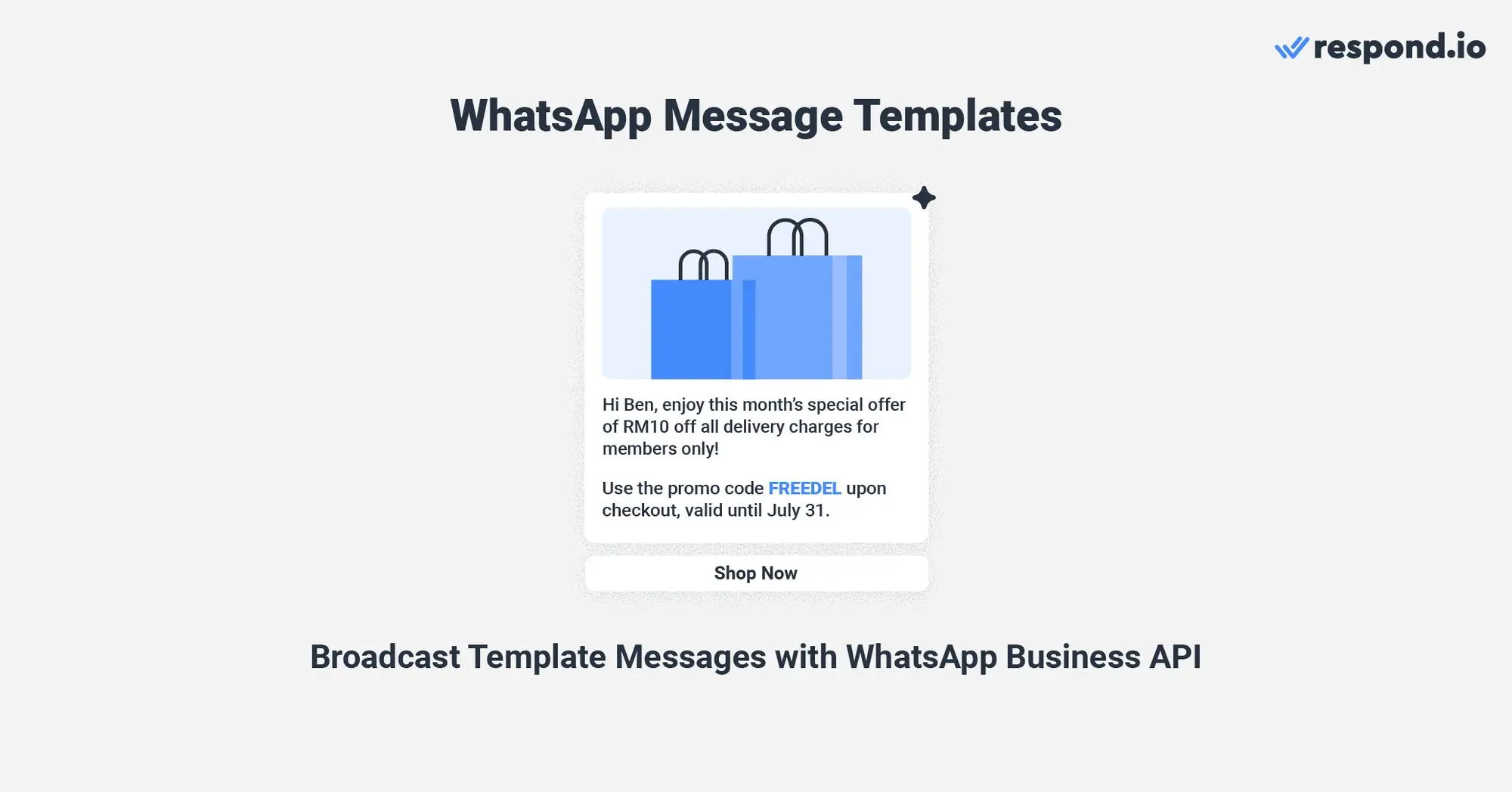
Zum Beispiel können Sie eine Nachricht mit einem Angebot senden, sobald der Kontakt zustimmt, und dann monatliche Nachrichten über die neuesten Angebote sowie gelegentliche Nachrichten zu Produkten senden, an denen sie Interesse gezeigt haben.
Sie können auch WhatsApp für Remarketing verwenden, um Ihren bestehenden Kunden ähnliche Produkte oder Upgrades vorzuschlagen. Ziehen Sie in Erwägung, einen Treue-Rabatt anzubieten, um das Angebot attraktiver zu machen.
Ab dem 1. April 2025 pausiert WhatsApp alle Marketing-Vorlagen an US-Telefonnummern (+1). Dies zielt darauf ab, die Benutzererfahrung und die Geschäftsergebnisse zu verbessern. Das Senden von Nachrichten nach diesem Datum führt zu einem Fehler.
Passen Sie Ihre Unterhaltungen weiter an und automatisieren Sie sie mit WhatsApp Drop-Kampagnen. Die meisten Leute werden keinen Kauf machen, wenn sie das erste Mal von einem Produkt hören. Sie müssen sie im Laufe der Zeit berücksichtigen und an ihren Wert erinnern.
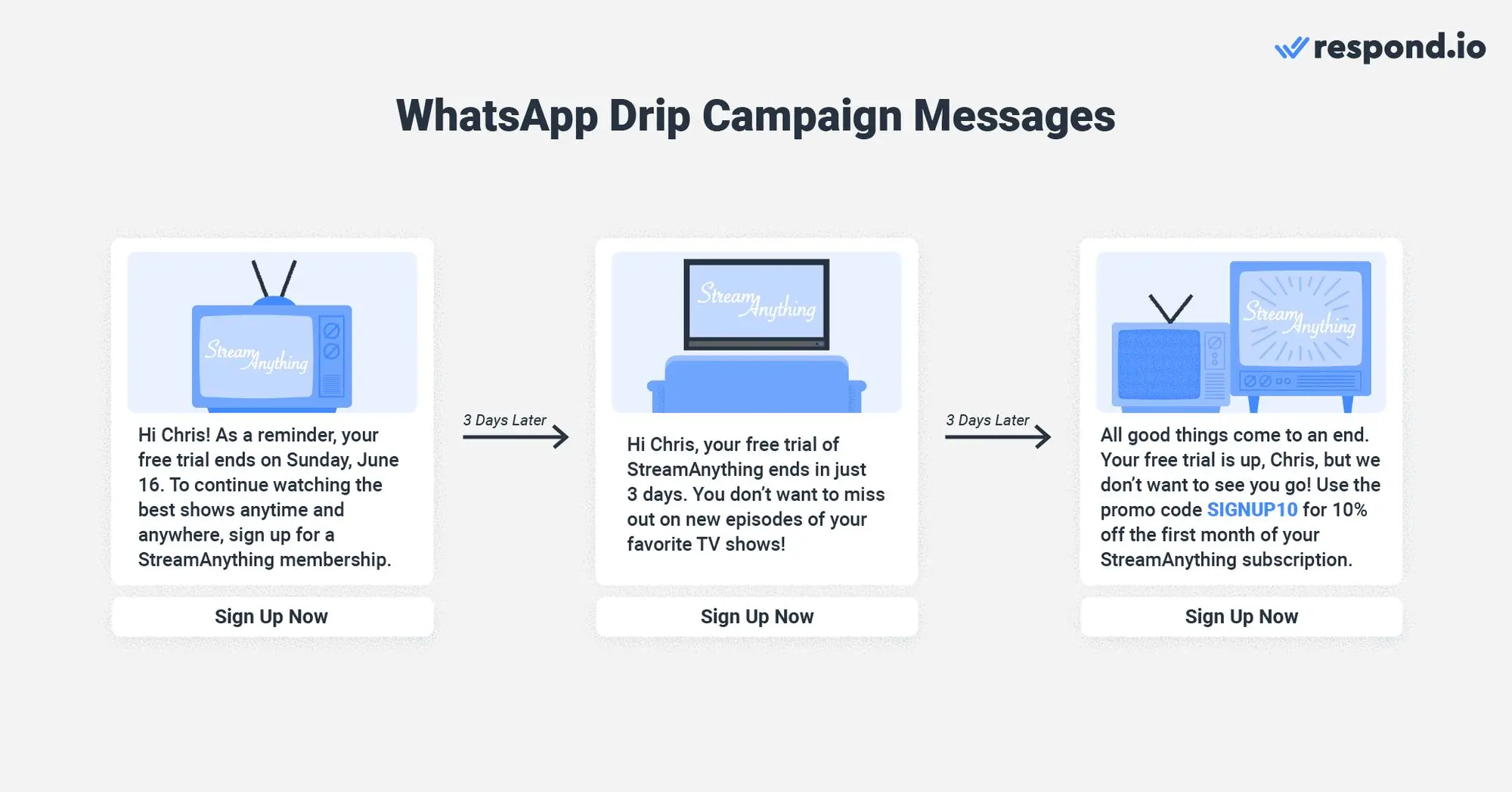
Setze Trigger um automatisierte Nachrichten zu senden, zum Beispiel, wenn sie einen verlassenen Warenkorb haben oder ihre Testversion kurz vor dem Ablauf steht. WhatsApp verlassene Warenkorbnachrichten geben Ihnen die Möglichkeit, bis zu 60% der Kunden zurückzuziehen.
Das Einrichten von WhatsApp Werbenachrichten als Reaktion auf bestimmte Triggerereignisse erfordert einen ähnlichen Prozess wieWhatsApp Push-Benachrichtigungen. Sie werdenbald in der Lage sein, dies über die Nachrichten-API durch eine Zapier-Integration zu tun.
Zufriedene Kunden machen Marketing für Sie, indem sie ihre Freunde empfehlen. Verwenden Sie respond.io um eine automatisierte Kundenzufriedenheitsbefragung zu erstellen. Dabei erhalten Sie nicht nur wertvolle Rückmeldungen, sondern auch hochzufriedene Kundenempfehlungsanreize.
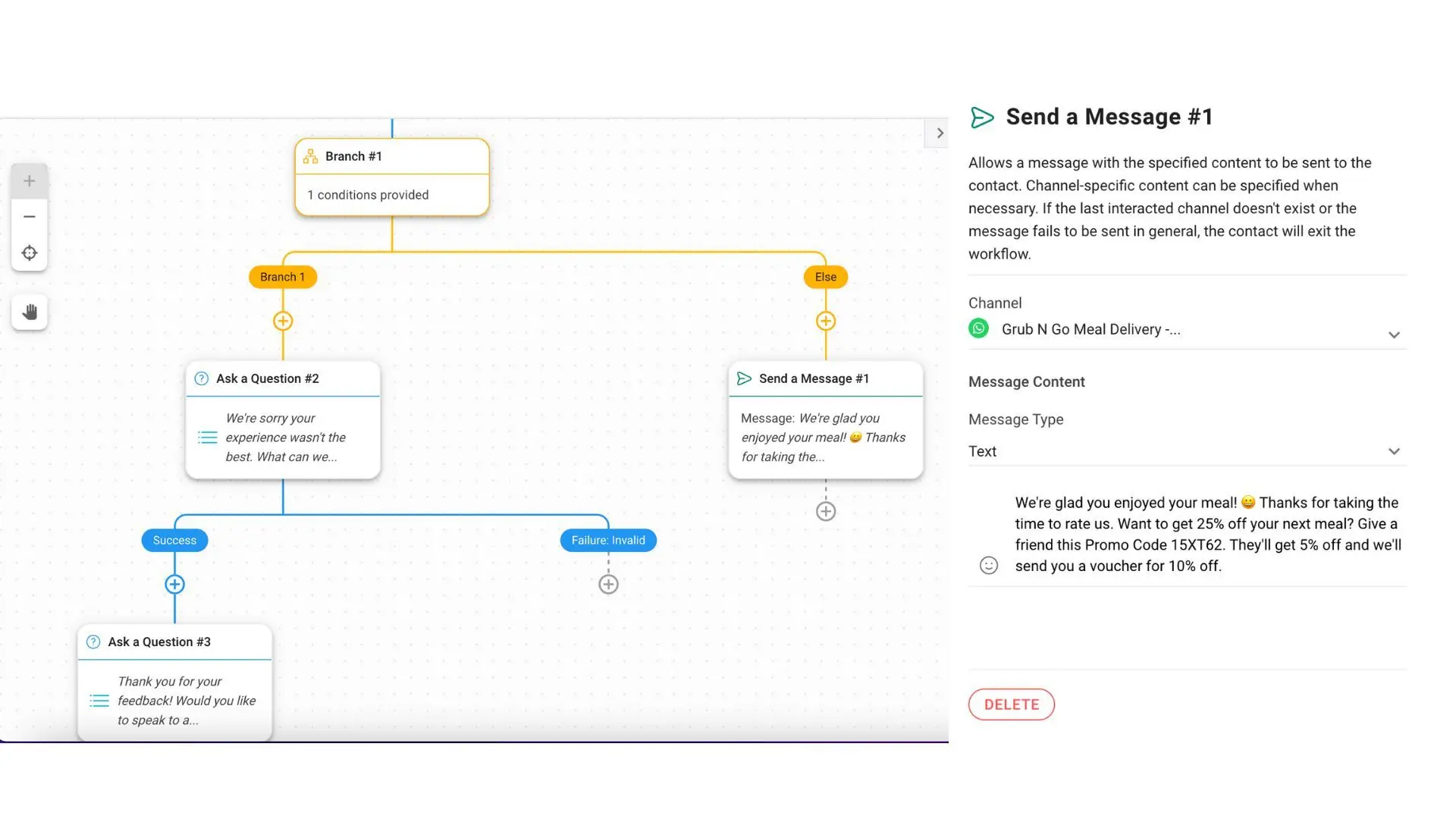
Zum Beispiel, erstellen Sie einen Workflow, in dem Kunden, die 4-5 Sterne in einer Umfrage gegeben erhalten einen Promo-Code zu teilen. Wenn der Code verwendet wird, erhält der Kunde einen Rabatt. Kunden, die 1-3 Sterne gegeben haben, erhalten die Möglichkeit, mit einem Agenten über ihre Probleme zu chatten.
Das Ziel des WhatsApp Marketings sollte Gespräche sein, die die Perspektiven zum Handeln führen. Klick-zu-Chat-Anzeigen sind eine großartige Möglichkeit, Leads dazu zu bringen, Informationen über ihre Bedürfnisse bereitzustellen. Wenn Sie Werbeaktionen senden, ist es auch wichtig, Kunden zu ermutigen, zu antworten, anstatt sie nur über eine Werbeaktion zu informieren.
Fügen Sie zum Beispiel einen CTA-Button wie „Rabatt erhalten“, „Jetzt einkaufen“ oder „RSVP“ hinzu. Die Anzahl der Antworten, die Sie erhalten, hilft, die Effektivität Ihres Marketings zu messen. Zusätzlich lässt es Meta wissen, dass die Empfänger Ihre Nachrichten wertvoll finden. Wenn Empfänger sich nicht mit Ihren Werbemitteilungen beschäftigen, besteht die Möglichkeit, dass weitere Marketingvorlagenarbeiten an diese Kunden nicht zugestellt werden.
Werbemitteilungen sind nützlich, um Kunden mit den neuesten Nachrichten oder speziellen Angeboten gezielt anzusprechen. Meta beschränkt jetzt Unternehmen auf das Versenden von zwei Marketingvorlagen pro Kunde in einem 24-Stunden-Zeitraum. Wenn der Kunde antwortet, können Sie eine zusätzliche Vorlage senden.
Wir empfehlen jedoch, weniger als diese zu versenden, um ein besseres Kundenerlebnis zu erzielen. Setzen Sie sich in die Schuhe des Kunden. Niemand möchte täglich eine WhatsApp-Nachricht von einem Unternehmen erhalten, selbst wenn er den Werbeaktionen zugestimmt hat. Planen Sie Ihre Nachrichten klug, um beispielsweise eine Aktion anzukündigen und dann eine weitere Erinnerung zu senden, wenn die Aktion kurz vor dem Ende steht.
Ob in Werbung, Social Posts mit Chat-Links oder Werbe-Nachrichten, visuelle Bilder helfen dabei, Aufmerksamkeit zu gewinnen. Erregen Sie in Anzeigen oder sozialen Medien mit kreativen Bildern oder Videos Neugier. Stellen Sie sicher, dass Ihr Angebot in den Vorlagen sofort übersichtlich ist. Fügen Sie zum Beispiel ein WhatsApp Katalog Bild hinzu, um einen Artikel zu präsentieren, der Rabatt hat.
Wir teilen einige Beispiele für erfolgreiche Marketing-Kampagnen im nächsten Abschnitt um Ihnen ein wenig Inspiration zu geben.
Marketing auf WhatsApp ist eine großartige Möglichkeit, Ihr Engagement zu steigern und letztlich Leads in Verkäufe umzuwandeln. Viele Unternehmen haben dies mit erfolgreichen WhatsApp Kampagnen bewiesen. Schauen wir uns einige davon an.
Die weltweit beliebte deutsche Lebensmittelmarke und Kochschule Maggi wollte die Kunden dazu ermutigen, zu Hause mit Maggi-Produkten zu kochen. Dazu entwickelte es einen virtuellen Kochkurs, der komplett über WhatsApp durchgeführt wurde.
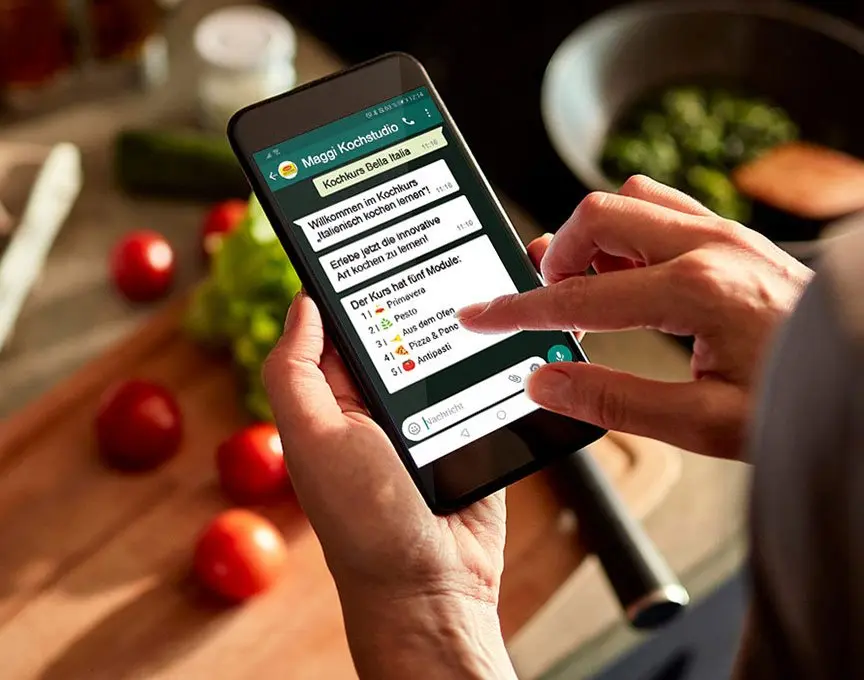
Benutzer senden Nachrichten an den virtuellen Assistenten Kim, der sie Schritt für Schritt durch einfache Rezepte führt. Kim bietet den Benutzern auch eine Einkaufsliste mit hilfreichen Tipps und Quizzen zu Ernährung und Lebensmittelsicherheit.
Maggi kündigte die WhatsApp Kampagne auf seiner Website, in Newslettern und in Pressemitteilungen an. Es wurde auch über Klick-to-Chat-Anzeigen auf Facebook und Instagram beworben.
In den ersten acht Wochen nach dem Start hatte Kim über 200.000 Nachrichten empfangen. Es gab einen signifikanten Anstieg des Markenbewusstseins, und Umfragen zeigten, dass die Werbung für diese WhatsApp-Kampagne ein 4,2-faches Erinnerungsniveau über andere Anzeigen hatte.
Kunden schätzen die persönliche Verbindung über eine App, die sie täglich nutzen. Auch wenn sie in der Vergangenheit vielleicht nicht über Kochkurse nachgedacht haben, haben ihre Interaktionen mit Kim ihnen gezeigt, wie einfach es ist, Kochen in ihre Routine zu integrieren.
Die indonesische Marke Vyatta produziert eine Reihe von technischen Accessoires, darunter Kopfhörer, Smartwatches, Lautsprecher und Ladegeräte. Es verwendet regelmäßig Facebook-Anzeigen um Käufer in seinen Online-Shop zu schicken.
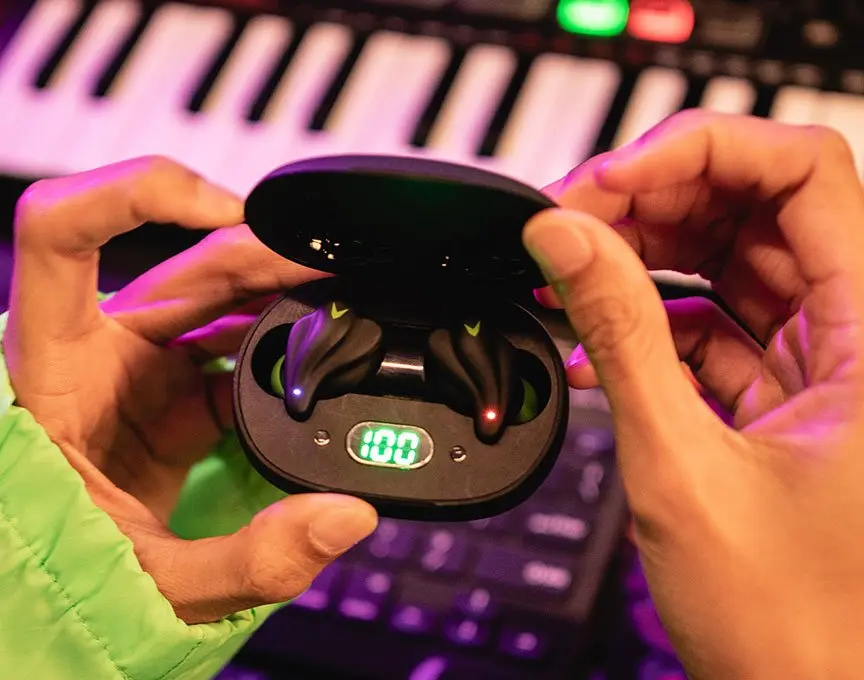
Allerdings wollte Vyatta sehen, ob das Chatten mit einem Vertriebsbeauftragten zu mehr Informationen über das Produkt die Einkäufe erhöhen würde, also versuchte es mit Klicken-zu-Chat-Anzeigen, die Käufer nach WhatsApp und nicht in den Laden leiten.
Um zu sehen, welche Methode erfolgreicher war und die Käufer zu WhatsApp oder zum Shop führte, führte Vyatta einen Split-Test über sechs Wochen aus. Es verwendet beide Arten von Anzeigen und dann die Ergebnisse verglichen.
Die Click-to-WhatsApp-Werbung war ein voller Erfolg. Vyatta stellte fest, dass diese Anzeigen zu 5X mehr Käufe bei 79% weniger Kosten pro Kauf.
Interessenten, die mit WhatsApp interagieren, sehen auch 2X mehr Produktseiten und führen 2X mehr Ad-to-Warenkorb-Aktionen durch als diejenigen, die mit den anderen Anzeigen interagieren.
Qobolak, ein Ausbildungsvermittlungsunternehmen, verbindet Studenten in den Golfküstenländern mit Universitäten in Großbritannien, USA, Europa und Australien. Sie generiert erfolgreich die meisten ihrer Leads auf Bildungsausstellungen, sieht sich jedoch Herausforderungen gegenüber, ihre Teilnahme an diesen Veranstaltungen potenziellen Studierenden effektiv mitzuteilen.
Das Senden vonWhatsApp Broadcasts via respond.iodiente als direkter Kanal, um solche Ankündigungen und Aktualisierungen einembreiten Publikumeffizient zukommen zu lassen.

Qobolak hat 49.800 WhatsApp-Broadcast-Nachrichten über acht Monate gesendet, um Interessenten über Bildungsmessen und Aktionen zu informieren und ihre Reichweite und Wirkung im Bildungsbereich zu verbessern.
Dieser neue Ansatz hat zu erheblichen Verbesserungen in der Sichtbarkeit und Teilnahme an Veranstaltungen geführt. Der Einsatz von WhatsApp-Broadcasts erwies sich als äußerst effektiv, was zu einer Steigerung der Lead-Conversions um 95 % führte. Dieser Ansatz hält Qobolak im Gedächtnis der Schüler und steigert das Engagement sowie verbessert schnell die Leadgenerierung und die Konversionsraten.
Haben diese Beispiele Ideen entfacht, die sich auf Ihr eigenes Unternehmen anwenden lassen? Um die vollen Vorteile zu erhalten, ist es am besten, sich für ein WhatsApp API Konto anzumelden, wie wir erklärt haben. Führen Sie Klick-zu-Chat-Anzeigen aus, segmentieren und zielen Sie auf Kunden ab, senden Sie Werbebotschaften und mehr, um Ihre Leads zu maximieren und sie aktiv zu halten.
Beginnen Sie noch heute mit der Implementierung Ihrer eigenen WhatsApp Marketing-Strategie. Melden Sie sich für ein respond.io Konto an, damit Sie WhatsApp API verbinden und alle Leads nahtlos verwalten können, die aus Ihren Kampagnen kommen.
Verwandeln Sie Gespräche in Kunden mit der offiziellen WhatsApp-API von respond.io. ✨
Verwalten Sie WhatsApp-Anrufe und -Chats an einem Ort!
Wenn Sie Marketingnachrichten über die WhatsApp API versenden, müssen Sie in der Marketing-Kategorie vorab genehmigte Vorlagen verwenden. Bewilligte Anwendungsfälle für diese Meldungen beinhalten Produktnachrichten, Werbeangebote, Neuausrichtung und Aufbau von Kundenbeziehungen.
WhatsApp beschränkt Unternehmen auf das Versenden von maximal zwei Marketingvorlagen in einem 24 Stunden Gesprächsfenster, ohne dass ein Kunde reagiert. Wenn ein Kunde antwortet, ist eine zusätzliche Marketingvorlage erlaubt undfreie FormNachrichten können verwendet werden, um die Unterhaltung fortzusetzen.
Es ist wichtig, WhatsApp-Nachrichten nur an Kunden zu senden, die sich für den Empfang von Nachrichten von Ihnen entschieden haben. Sie sollten auch vermeiden, in kurzer Zeit zu viele Nachrichten zu senden. Wenn Sie regelmäßig Werbe-Nachrichten versenden, können Empfänger Ihr Geschäft als Spam blockieren, auch wenn sie sich zuvor dafür entschieden haben.
WhatsApp Marketing ist besser als E-Mail, wenn Ihr Publikum WhatsApp als bevorzugten Instant-Messaging-Kanal verwendet. Die meisten Werbe-E-Mails bleiben ungelesen im Posteingang oder landen im Spam-Ordner. Deshalb liegt die Öffnungsrate von E-Mails bei etwa 15%; 85% der Empfänger schauen sich Ihre E-Mails nicht einmal an. Im Gegensatz zu der geringen Öffnungsrate von E-Mails werden80% der WhatsApp Nachrichten innerhalb von 5 Minuten angezeigt.
Um mehr über die Verwendung von WhatsApp für das Marketing zu erfahren, schauen Sie sich diese Artikel an:
Susan Swier trat 2022 als Senior Content Manager bei respond.io. Sie ist Absolventin des St. John's College und hat einen Masterabschluss in Liberal Arts. Mit mehr als zehn Jahren Erfahrung im Bildungswesen hat Susan verschiedene Positionen bei Wiseman Education, dem British Council und Pearson inne. Ihre Artikel konzentrieren sich auf die Kommunikation von Kunden, um Unternehmen bei der Komplexität von Business-Messaging-Apps wie Viber Business zu unterstützen.

Erfahren Sie, wie Sie auf WhatsApp API upgraden, ohne Sprachanrufe zu verlieren. Verbinden Sie Nachrichten und Stimme, um Vertrauen zu schaffen, komplexe Probleme zu lösen und sich abzuheben.